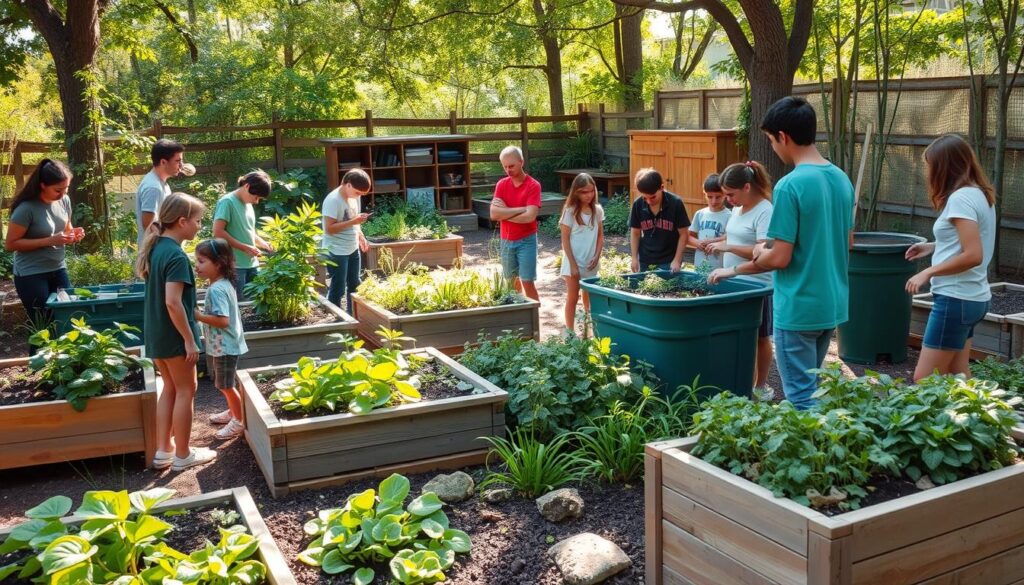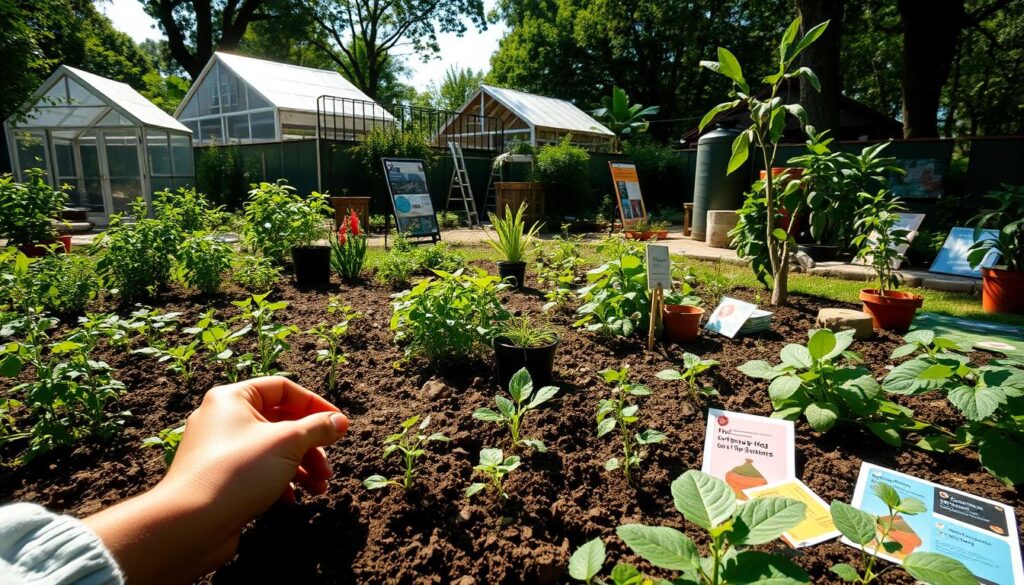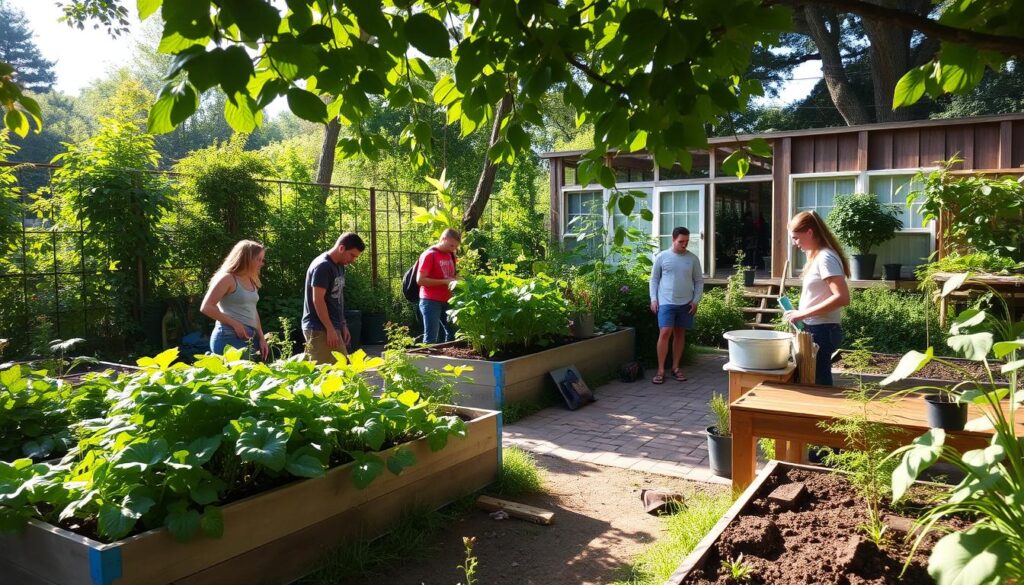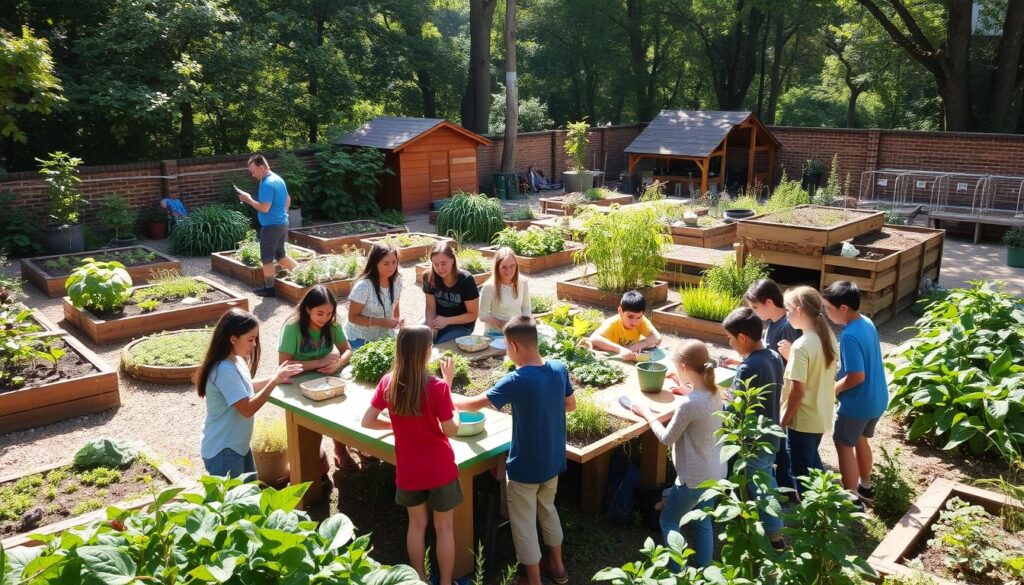What does it take to become a certified permaculture teacher? This role inspires others to live sustainably. As more people seek permaculture education, the need for certified teachers grows. This makes permaculture teaching certification very valuable.
Permaculture education is key to promoting sustainable living. With a teaching certification, you can teach others about permaculture. This article will cover how to get certified, including the importance of education and training in sustainable living.
Key Takeaways
- Permaculture teaching certification is an internationally recognized qualification that enables individuals to teach permaculture and design their own unique programs.
- Permaculture education is essential for promoting sustainable practices and ecological design.
- Permaculture teaching certification provides individuals with the skills and knowledge needed to design and deliver effective permaculture programs.
- The demand for permaculture-skilled educators is increasing globally, addressing climate and biodiversity crises.
- Permaculture teaching certification can be obtained through various programs, including online and in-person courses.
- Graduates of permaculture teaching certification programs can gain access to discounted opportunities in the Permaculture Educators Program.
What is Permaculture Teaching Certification?
Permaculture teaching certification lets people teach permaculture and create their own programs. It’s based on permaculture’s principles, which focus on growing food efficiently and caring for the earth. This approach emphasizes earth care, people care, and sharing, making it key in permaculture education.
Permaculture is crucial for sustainable practices. It helps design and implement sustainable solutions. Ecological design certification teaches individuals to build regenerative systems. Also, green living certification programs use permaculture principles for a complete sustainable lifestyle.
Getting permaculture teaching certification deepens one’s understanding of permaculture. It’s great for those in permaculture education. It lets them share their knowledge and help grow sustainable communities.
Benefits of Obtaining a Certification
Getting a permaculture teaching certification can really help you grow. It lets you improve your skills in design, teaching, and working with communities. You can learn all this through an organic farming course, which teaches you how to live sustainably.
Having this certification can also open doors to new jobs. You might teach, consult, or help build communities. You could even start eco-friendly learning programs to spread the word about caring for our planet. Plus, you can teach others about the need for sustainable living through environmental education programs.
Some key benefits of getting a permaculture teaching certification are:
- Improving your skills in permaculture design and teaching
- Starting eco-friendly learning programs
- Teaching others about environmental conservation
- Finding better job opportunities in permaculture education
In summary, getting a permaculture teaching certification is a great choice. It gives you the tools and knowledge to help make our world a greener place.
Certification Programs Overview
There are many programs for those wanting a permaculture teaching certification. These programs give you the tools to teach permaculture. They focus on ecological design and sustainable living.
These courses cover topics like regenerative design and social permaculture. You’ll get both hands-on experience and theoretical knowledge. This prepares you for a career in teaching permaculture.
- Permaculture Design Certification (PDC)
- Ecological Design Certification
- Sustainable Living Training
Places like the Occidental Arts & Ecology Center offer these certifications. They have programs accredited by the Permaculture Institute of North America (PINA). These programs help you understand permaculture and apply it in real life.
| Program | Duration | Cost |
|---|---|---|
| Permaculture Design Certification | 6 weekends over 6 months | $1,295 |
| Summer Intensive | 2 weeks | $2,195 |
Requirements for Certification
To get a permaculture teaching certification, you need to meet some key requirements. These include things you must know and skills you must have. Getting a green living certification is possible through learning and doing.
Some important things you need to be certified include:
- Completing a permaculture design course
- Having skills in teaching and community work
- Getting practical experience in permaculture
These steps help make sure you really understand permaculture. They also make sure you can teach others well. By going through a permaculture education program, you can become a certified teacher. This helps grow environmental education.

| Requirement | Description |
|---|---|
| Permaculture Design Course | A 72-hour course that provides a foundation for understanding permaculture principles and practices |
| Teaching and Community Engagement Skills | Skills and knowledge needed to teach others and engage with the community |
| Practical Experience | Hands-on experience in permaculture design and implementation |
Curriculum Components of Certification Programs
Permaculture teaching certification programs offer a deep dive into permaculture design and teaching. They include an organic farming course. This course covers soil carbon sequestration, water harvesting, and urban permaculture.
Students get to participate in eco-friendly learning through hands-on activities and community engagement. The curriculum also includes sustainable living training. This covers renewable energy systems, natural building, and regenerative principles.
Programs may have different modules. These include permaculture principles and ethics, urban permaculture, and aquaculture. These modules aim to give students a broad understanding of permaculture.
By focusing on organic farming course, eco-friendly learning, and sustainable living training, these programs prepare students. They learn to promote sustainable living and regenerative practices.
Duration and Commitment
The time needed for permaculture teaching certification programs varies. Some, like the Permaculture Educators Program, offer flexible learning. It has 43 modules delivered weekly for at least 43 weeks. This lets participants work on projects in their own places and communities over 10 months or more.
Other programs, like the Permaculture Design Certification Course (PDC), need a minimum of 72 hours of training. The PDC costs $1,400 plus accommodations. Students must attend both parts of the course to get a certificate. The course mixes learning styles through activities in gardens and orchards.
Getting certified takes a lot of time, but the flexible learning formats help. For example, the Permaculture Educators Program has weekly Q&A sessions and monthly masterclass topics chosen by participants. This offers more tailored learning. Participants can also travel with the instructor to places like Africa.
Here are some key features of permaculture teaching certification programs:
- Flexible learning formats, including online and in-person programs
- Minimum duration of 43 weeks to 10 months or more
- Opportunities for hands-on learning and project work
- Support from instructors and peers through Q&A sessions and masterclasses
- Eligibility for certification from reputable organizations, such as the Permaculture Institute of North America (PINA)
Knowing the time and commitment needed for permaculture teaching certification programs helps. It lets individuals make informed choices about their permaculture education and ecological design certification goals.
| Program | Duration | Format |
|---|---|---|
| Permaculture Educators Program | 43 weeks to 10 months or more | Online |
| Permaculture Design Certification Course (PDC) | 72 hours or more | In-person and online |
Costs Associated with Certification
Thinking about getting a permaculture teaching certification? It’s key to know the costs involved. These can change based on the school, location, and type of certification. Programs in sustainable living and green living often cost a lot but can lead to a rewarding career in teaching about the environment.
Tuition for these programs can be anywhere from $500 to $1,500 or more. This depends on how long and in-depth the course is. You’ll also need to pay for books, software, and tools. Plus, some programs might ask you to do fieldwork or internships, which can cost extra.
- Oregon State University’s 10-week course: $900 USD
- The Permaculture Student PDC + Advanced PDC: $600 USD
- Quail Springs’ online PDC: $600-$1,500 USD
These prices show how different permaculture courses can vary. It’s smart to look around and compare to find the right program for your budget and goals.
Finding the Right Certification Program
Finding the right certification program in permaculture education is key. There are many options, so it’s important to research and compare them. Look into the program’s accreditation and reputation to ensure it’s respected in the field.
An organic farming course can teach valuable skills. Eco-friendly learning is also crucial, offering hands-on experience in sustainable practices. These factors help you choose the best certification program for you.
When comparing programs, consider the curriculum, teaching style, and cost. Here’s a table comparing different permaculture certification programs:
| Program | Cost | Duration | Format |
|---|---|---|---|
| Permaculture Design Certificate Course (PDC) | $550 USD | 72 hours | Online or in-person |
| Introduction to Agroforestry Design | $279 USD | Variable | Online |
| Climate Adaptation Certificate Course | $279 USD | Variable | Online |
By evaluating these factors, you can find a program that meets your goals. It should offer a well-rounded permaculture education, including organic farming and eco-friendly learning.

Online vs. In-Person Certifications
Choosing between online and in-person certifications for permaculture teaching, sustainable living, or ecological design is a big decision. Online learning is flexible and convenient, letting you study anywhere, anytime. Traditional classroom settings, on the other hand, offer hands-on training and community interaction.
Online learning has its perks:
- Flexibility in scheduling
- Convenience of location
- Self-paced learning
In-person certifications, though, provide:
- Hands-on training and practical experience
- Opportunities for community engagement and networking
- Direct interaction with instructors and peers
Choosing between online and in-person depends on your learning style and preferences. It’s important to weigh the pros and cons of each. This way, you can pick the best option for your education and career goals.
| Certification Type | Advantages | Disadvantages |
|---|---|---|
| Online | Flexibility, convenience, self-paced learning | Limited hands-on training, lack of community engagement |
| In-Person | Hands-on training, community engagement, direct interaction with instructors and peers | Limited flexibility, requires physical presence |
Role of Experienced Instructors
Experienced instructors are key in permaculture education. They guide and support those seeking a green living certification. A good permaculture program relies on its teachers, who must know and teach permaculture well.
In environmental education, it’s vital to have instructors with the right background. For example, the Finger Lakes Permaculture Institute (FLPCI) has run a 72-hour Permaculture Design Certificate Course for over 8 years. Their teachers have over 40 years of global teaching and consulting experience.
What makes a good permaculture educator? They should have:
- At least five years of experience in teaching, consulting, and aid work in permaculture.
- Be able to speak more than one language, showing a global focus.
- Know how to manage a marketing and communications budget well.
Learning from these experienced teachers helps individuals become skilled permaculture educators. They can then make a difference in their communities. For more on permaculture teacher training, visit permaculture teacher training programs.
With the right training and instructors, one can start a career in permaculture education. This path leads to a sustainable future through green living and environmental education.
Practical Experience and Hands-On Learning
Practical experience and hands-on learning are key in permaculture teaching certification programs. These programs let people use what they’ve learned in real-world settings. This way, they can improve their skills and feel more confident. An organic farming course is a perfect example, where students learn to farm sustainably and apply what they’ve learned.
Many permaculture programs offer fieldwork, internships, and apprenticeships. These chances let students work with experienced teachers and learn from them. Eco-friendly learning is a big part of these programs, teaching students about sustainable living. Some programs even include sustainable living training, helping students teach others about living green.
By focusing on practical experience, permaculture programs prepare students to teach others. These programs help students understand permaculture better. They also give students the tools to share sustainable living and eco-friendly practices with others.
Networking Opportunities through Certification
Getting a permaculture teaching certification opens doors to a community of like-minded people. They all share a passion for teaching permaculture and ecological design. This network is great for growing your career in permaculture teaching.
Permaculture education connects you with others who love sustainable practices and design. You can work together, share knowledge, and support each other. Being part of this community keeps you updated on the latest in permaculture education and design.
Some benefits of networking through permaculture teaching certification include:
- Access to a community of like-minded individuals who share a passion for permaculture education and ecological design certification
- Opportunities for collaboration and knowledge sharing
- Support and guidance from experienced permaculture educators
- Stay up-to-date on the latest developments and best practices in permaculture education and ecological design certification
By using these networking chances, you can improve your skills in permaculture education and design. This leads to more success and happiness in your career as a permaculture educator.
Post-Certification Options
After finishing a permaculture teaching certification program, you have many choices. You can get into sustainable living training and green living certification. These can help you focus on certain parts of permaculture. An environmental education program can also deepen your knowledge of permaculture.
There are options like continuing education and advanced certifications. These can keep you up-to-date with new permaculture ideas. They also offer chances for career growth and networking.
Continuing Education and Advanced Certifications
For permaculture experts, continuing education and advanced certifications are key. They let you refresh your skills and dive into specific permaculture areas.
Career Paths Available After Certification
With a permaculture teaching certification, you can explore many careers. You might teach, consult, or design. These jobs are both rewarding and challenging.
They give you a chance to use your knowledge in real-world projects. The need for sustainable living training and green living certification is growing. This means you can stand out in the job market and help the environment through environmental education program.
Challenges in Pursuing Certification
Getting a permaculture teaching certification is rewarding but comes with challenges. One big hurdle is balancing school with work and family. Many who want to learn about organic farming face trouble finding the time and money for a certification.
Another challenge is the cost. Certification programs can be very expensive. This makes it hard for some to get into permaculture education and eco-friendly learning. Recent data shows many face barriers like cost, travel, and family obligations.
Common Obstacles
- High cost of certification programs
- Difficulty in balancing education with other commitments
- Lack of access to permaculture education and eco-friendly learning opportunities
Despite these hurdles, many still want to get certified. The need for sustainable practices is growing. Knowing the challenges helps prepare for the journey ahead. It helps make informed choices about permaculture education and eco-friendly learning.

Case Studies of Successful Permaculture Educators
Many people have become successful in teaching permaculture thanks to certification. This certification in ecological design helps them teach sustainable living. They create systems that protect the environment and help communities.
A small land project grew into a big market garden, making lots of money. It showed how to farm sustainably. The founders’ success came from their permaculture teaching certification and sustainable living training.
Here are some stats on permaculture’s impact:
- Over 1,000,000 people are certified in permaculture in more than 140 countries.
- There are more than 4,000 permaculture projects worldwide.
- Permaculture helps 15% of the global population who are malnourished.
These success stories prove that permaculture teaching certification and sustainable living training work. They show how to make a difference and promote ecological design.
| Year | Profit | Labor Cost |
|---|---|---|
| Year Two | $5,500 | $15,600 |
| Year Three | $42,000 | $37,800 |
| Year Five | $72,000 | $40,000 |
Future Trends in Permaculture Education
Permaculture education is changing to meet the world’s growing need for sustainable practices. It focuses on green living certification and environmental education program. This is key for those wanting a sustainable future. In Canada and the US, 35 universities now offer Permaculture Design Courses (PDC) or permaculture programs for credit.
The demand for sustainable practices is on the rise. This is making permaculture education more exciting and dynamic. For instance, permaculture practice is improving animal welfare through sustainable farming. Some trends in permaculture education include:
- Increased recognition of Permaculture Design solutions relevant to environmental changes and societal challenges
- Advanced training options available in areas such as Regenerative Organic Agriculture, Ecological Restoration, and Renewable Energy Systems Design
- Emphasis on hands-on experiential learning prioritized by professionals working in Permaculture

As permaculture education evolves, we’ll see new ways to teach permaculture. It’s all about permaculture education, green living certification, and environmental education program. Permaculture education is set to play a big role in our sustainable future.
| Trend | Description |
|---|---|
| Increased recognition of Permaculture Design solutions | Permaculture Design solutions are being recognized as relevant to environmental changes and societal challenges |
| Advanced training options | Advanced training options are available in areas such as Regenerative Organic Agriculture, Ecological Restoration, and Renewable Energy Systems Design |
| Emphasis on hands-on experiential learning | Hands-on experiential learning is being prioritized by professionals working in Permaculture |
Conclusion: The Value of Permaculture Teaching Certification
A permaculture teaching certification is very valuable. It helps you teach permaculture and design your own programs. You’ll learn how to share permaculture principles and create sustainable solutions for different communities.
Getting a permaculture education certification opens doors to a fulfilling career. You can become an educator, advocate, and consultant. This way, you can make a big difference in people’s lives. The certification also lets you use sustainable practices in your teaching and design work.
If you love creating food forests, using new water management methods, or connecting people with nature, this certification is for you. It gives you the tools to make your dreams come true. Use this chance to be a positive change-maker in your community and beyond.

